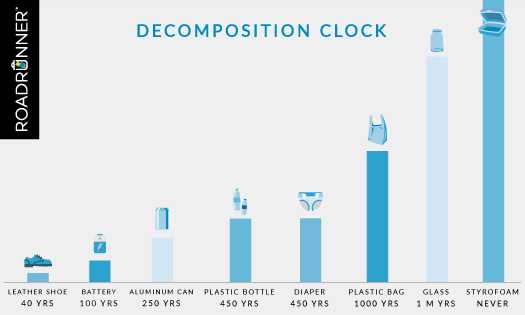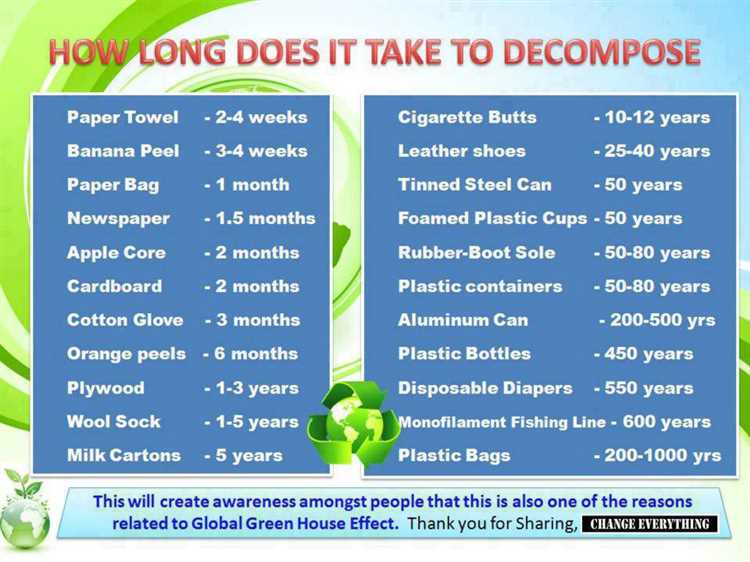
When we think of natural processes, we often envision the rapid changes that occur in the world around us. However, there are some processes that are so slow and seemingly insignificant that they often go unnoticed. One such process is decomposition, the breakdown of organic matter. While we may not give decomposition much thought, it is a critical component of the earth’s ecosystem and an essential part of the cycle of life and death.
Decomposition is a complex and fascinating process that involves the breakdown of once-living organisms into simpler substances. The rate at which decomposition occurs depends on a variety of factors, including temperature, moisture, and the presence of oxygen. In some cases, decomposition can occur relatively quickly, taking only a matter of weeks or months. However, there are certain types of matter that can take an incredibly long time to decompose, sometimes hundreds or even thousands of years.
One of the slowest forms of decomposition is the breakdown of materials such as plastic and glass. These man-made materials are not naturally biodegradable and can persist in the environment for hundreds of years. In fact, it is estimated that plastic bottles can take up to 450 years to decompose, while glass bottles can take up to 1 million years. This longevity of decomposition for these materials is a significant concern for the environment, as it contributes to pollution and waste accumulation.
- The Slowest Natural Processes
- The Longevity of Decomposition
- Factors Affecting Decomposition Rate
- 1. Environmental Conditions
- 2. Composition of Organic Materials
- 3. Presence of Microorganisms
- Uncommonly Slow Decomposition Processes
- The Preservation of Fossils
- The Preservation of Ancient Wood
- Examples of Slow Decomposition in Nature
- The Significance of Slow Decomposition Processes
- Nutrient Cycling
- Carbon Sequestration
- Ecosystem Stability
- Q&A:
- Why do some materials take so long to decompose?
- What are some examples of materials that decompose very slowly?
- What are the consequences of materials taking a long time to decompose?
- Can anything be done to speed up the decomposition process?
- Are there any natural processes that can accelerate the decomposition of materials?
- What are some of the slowest natural processes?
The Slowest Natural Processes
When we think about the natural world, we often imagine fast-paced phenomena like the crashing of waves or the growth of a tree. However, there are also many natural processes that occur at an incredibly slow pace. These processes can take hundreds, thousands, or even millions of years to complete.
One of the slowest natural processes is the erosion of rocks and mountains. Over time, wind, water, and other environmental factors gradually wear away at the surface of the earth. This process is so slow that it can be difficult to perceive any change within a human lifetime.
Another slow process is the formation of fossils. When a plant or animal dies, its remains can become fossilized over time. This process occurs as layers of sediment gradually build up and compress the remains, turning them into rock-like structures. The formation of fossils can take millions of years, making it one of the slowest processes in nature.
Similarly, the formation of caves is an incredibly slow process. Over time, the dissolution of rock by underground water leads to the creation of intricate cave systems. This process can take thousands or even millions of years to complete, resulting in stunning cave formations like stalactites and stalagmites.
Additionally, the movement of tectonic plates is a slow but powerful process that shapes the Earth’s surface. Over millions of years, these plates slowly shift and collide, creating mountains, valleys, and other geological features. While the movement may be imperceptible to humans, its impact is visible in the vast landscapes that surround us.
These slow natural processes remind us of the incredible age of the Earth and the patience required to witness their completion. They serve as a humbling reminder that nature operates on its own timescale, one that is far different from the busy, fast-paced world of humans.
The Longevity of Decomposition
Decomposition is a natural process that occurs when organic matter breaks down into simpler substances. It is a vital part of the ecosystem, as it helps to recycle nutrients and return them to the soil. The length of time it takes for decomposition to occur can vary greatly depending on a number of factors.
One of the main factors that influences the longevity of decomposition is the type of material being broken down. Some materials, such as leaves and twigs, decompose relatively quickly due to their high carbon content. Others, like wood and bones, take much longer to decompose because they are more resistant to decay.
In addition to the material itself, environmental conditions also play a significant role in the speed of decomposition. Decomposition occurs more rapidly in warm, moist environments, where bacteria and other microorganisms are more active. On the other hand, cold, dry conditions can slow down the decomposition process significantly.
Another factor that affects the longevity of decomposition is the presence of scavengers and decomposers. Animals like insects and worms, as well as bacteria and fungi, help to break down organic matter. Their presence can accelerate the decomposition process, while the absence of these organisms can significantly delay it.
Furthermore, certain chemicals and substances can also impact the rate of decomposition. For example, acidic environments can hinder the breakdown of organic matter, while alkaline environments can accelerate it. Similarly, the presence of oxygen can speed up decomposition, whereas anaerobic conditions can slow it down.
The longevity of decomposition is a fascinating aspect of the natural world. Understanding the factors that influence this process can help us better manage waste and promote sustainability. By providing the right conditions for decomposition to occur, we can contribute to a healthier ecosystem and reduce our impact on the environment.
Factors Affecting Decomposition Rate
There are several factors that can significantly affect the rate of decomposition. Understanding these factors is crucial in predicting the longevity of decomposition processes and managing waste effectively. Here are some of the key factors:
1. Environmental Conditions
The environment in which organic materials are exposed plays a crucial role in their decomposition. Temperature, humidity, and oxygen availability are the main factors that influence the rate of decomposition. Warmer temperatures accelerate decomposition, while extreme cold can slow it down significantly. Similarly, high humidity levels create favorable conditions for decomposition, whereas low humidity can hinder the process. Adequate oxygen supply is essential for the activities of aerobic bacteria, which are responsible for breaking down organic matter.
2. Composition of Organic Materials

Not all organic materials decompose at the same rate. The chemical composition of organic matter determines its susceptibility to decomposition. Materials rich in carbon, such as leaves and wood, tend to decompose more slowly compared to materials rich in nitrogen, like food waste. The carbon-to-nitrogen ratio greatly influences the speed of decomposition.
Fun fact: The term “brown” and “green” materials are often used to classify organic matter based on their carbon-to-nitrogen ratio. Brown materials, such as dried leaves and wood chips, have a higher carbon content, while green materials, like fresh grass clippings and kitchen scraps, have a higher nitrogen content. A good balance of brown and green materials is necessary for efficient composting.
3. Presence of Microorganisms
Microorganisms, including bacteria, fungi, and invertebrates like earthworms, are fundamental to the decomposition process. These organisms break down complex organic compounds into simpler forms, facilitating decomposition. The presence of a diverse microbial community and the availability of microorganisms that are specialized for decomposing specific types of organic matter can significantly enhance the decomposition rate.
It is important to note that the factors mentioned above are interconnected and can influence each other. For example, environmental conditions greatly affect the presence and activity of microorganisms, which, in turn, can affect the rate of decomposition. Scientists continue to research and unravel the complex dynamics of decomposition in order to unlock its potential for waste management and environmental sustainability.
Uncommonly Slow Decomposition Processes
While decomposition is generally a slow process, there are some uncommonly slow decomposition processes that defy expectations. These processes can take decades, centuries, or even millennia to complete, contributing to the preservation of certain materials and remains.
The Preservation of Fossils
Fossils are one notable example of uncommonly slow decomposition. When an organism dies in an environment conducive to fossilization, such as a sediment layer in a riverbed or an ancient lake, the decomposition process can be extremely slow. Over time, the organic material is gradually replaced by minerals, resulting in the formation of a fossil.
This process can take millions of years and requires specific geological conditions for preservation. Fossils have provided valuable insights into the history of life on Earth, allowing scientists to study prehistoric organisms and their environments.
The Preservation of Ancient Wood
Ancient wood, such as that found in archaeological sites or preserved in peat bogs, can also undergo an uncommonly slow decomposition process. In environments where there is a lack of oxygen, such as waterlogged or oxygen-depleted areas, wood can undergo a process called anaerobic preservation.
This process involves the gradual breakdown of wood by microorganisms that can survive without oxygen. The absence of oxygen slows down decomposition, leading to the preservation of wood for thousands of years. Ancient wooden structures and artifacts have been discovered in remarkable condition, providing important insights into past cultures and civilizations.
These uncommonly slow decomposition processes highlight the complexity and diversity of the natural world. By studying these processes, scientists can gain a better understanding of the factors that influence decomposition rates and the long-term preservation of materials.
Examples of Slow Decomposition in Nature

Decomposition is a natural process that occurs over time as organic matter breaks down and is recycled back into the environment. While decomposition rates can vary greatly depending on various factors, such as temperature, moisture, and the presence of decomposers, there are certain materials that are notoriously slow to decompose. Here are a few examples of slow decomposition in nature:
| Material | Approximate Decomposition Time |
|---|---|
| Plastic Bottles | 450 years or more |
| Glass Bottles | 1 million years or more |
| Aluminum Cans | 80-200 years |
| Styrofoam | Over 500 years |
| Disposable Diapers | 450 years or more |
| Leather | 50 years or more |
These materials, commonly used in everyday life, have a significant impact on the environment due to their slow decomposition rates. Plastic bottles, for example, take hundreds of years to fully break down, leading to pollution in landfills and oceans. Glass bottles and aluminum cans also contribute to waste accumulation, as they remain intact for thousands of years.
It is important to be aware of the long decomposition times of these materials and to consider alternative options that are more eco-friendly and sustainable. Recycling, reusing, and reducing overall consumption can help reduce the amount of waste that ends up in landfills and contribute to a healthier environment for future generations.
The Significance of Slow Decomposition Processes
As natural processes go, decomposition may seem like a relatively insignificant one. However, the slowest decomposition processes have significant impacts on ecosystems and the planet as a whole. Here are a few reasons why these processes are so important:
Nutrient Cycling
Slow decomposition processes play a crucial role in nutrient cycling. When organic matter decomposes slowly, it releases nutrients back into the soil instead of being quickly taken up by other organisms. This allows for a more efficient cycling of nutrients, ensuring a continuous supply for plants and other organisms in the ecosystem.
Carbon Sequestration
Slow decomposition processes also contribute to carbon sequestration. When organic matter decomposes slowly, carbon is stored in the soil rather than being released into the atmosphere as carbon dioxide. This helps mitigate climate change by reducing greenhouse gas emissions and preserving carbon stocks in ecosystems.
Ecosystem Stability
The slow decomposition of organic matter helps maintain ecosystem stability. By providing a gradual release of nutrients, slow decomposition processes support a diverse range of plant species, which in turn support a variety of animals. This promotes biodiversity and resilience in ecosystems, making them more capable of withstanding disturbances such as climate change or invasive species.
Overall, the significance of slow decomposition processes lies in their role in nutrient cycling, carbon sequestration, and ecosystem stability. By understanding and conserving these processes, we can better protect and manage our natural resources for the benefit of current and future generations.
Q&A:
Why do some materials take so long to decompose?
Some materials take a long time to decompose because they are resistant to the natural processes that break down organic matter. For example, plastics are made of polymers that are very stable and not easily broken down by bacteria and other decomposers.
What are some examples of materials that decompose very slowly?
Some examples of materials that decompose very slowly include plastic bottles, aluminum cans, glass bottles, Styrofoam, and cigarette butts. These materials are extremely durable and can persist in the environment for hundreds or even thousands of years.
What are the consequences of materials taking a long time to decompose?
The consequences of materials taking a long time to decompose include increased pollution and waste accumulation in the environment. For example, plastic waste can end up in oceans and other ecosystems, posing a threat to marine life. Slow decomposition also means that valuable resources are not being effectively recycled and reused.
Can anything be done to speed up the decomposition process?
Yes, there are a few ways to speed up the decomposition process. One method is to create controlled environments, such as composting systems or bioreactors, where conditions can be optimized for decomposers to thrive. Another approach is to develop new technologies that can break down difficult-to-decompose materials, such as advanced recycling methods for plastics.
Are there any natural processes that can accelerate the decomposition of materials?
Yes, there are natural processes that can accelerate the decomposition of materials. For example, increased temperature and humidity can speed up decomposition by creating more favorable conditions for decomposers. Additionally, certain microorganisms and insects have specialized digestive enzymes that can break down complex molecules more efficiently, resulting in faster decomposition.
What are some of the slowest natural processes?
Some of the slowest natural processes include the decomposition of organic matter, the formation of fossil fuels, and the erosion of mountains.